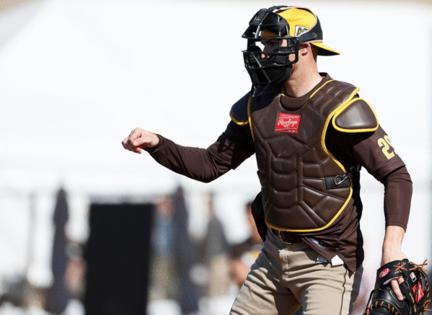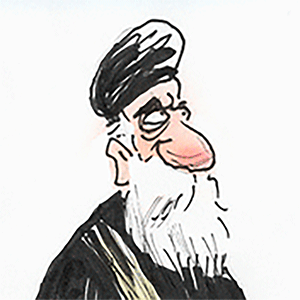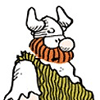Padres eager to see ball-strike challenge system up close during spring training games
Published in Baseball
Brett Sullivan caught a couple of games at the University of the Pacific, but he didn’t truly move behind the plate until 2016, his second year in the Tampa Bay Rays system. The 30-year-old veteran continues to bounce around the diamond to remain a versatile bench option for the Padres, but it would not be wise to question his command of the strike zone.
Just ask plate umpire … wait, what’s his name?
Even if Sullivan could remember the umpire that he went 10 for 11 against in challenges last year in baseball’s experimental automated ball-strike system (ABS), he’d never out him in public.
“Oh, I rip ‘em,” Sullivan said with a laugh. “As a catcher, I’m ripping (those challenges). … I felt like I umpired that game.”
The Padres view Sullivan as a valuable resource as the team begins to wrap its head around the ABS challenge system that will receive a trial run in spring training games this year. The system has been refined since its earliest inception in 2019 in the independent Atlantic League and could be introduced to the majors as soon as 2026 if baseball’s executives receive positive feedback.
The feel of it all will be as important as the data collected from the trial.
“What do the players think about it?” Morgan Sword, MLB executive vice president of baseball operations, said of the measurables the game is looking to collect. “Just their experience with the system. Do they feel like baseball was a better game? Was it more fair?”
Because the Hawk-Eye technology needed for the system is only installed in 13 of 23 spring training ballparks, roughly 60% of spring games will use the challenge system this spring. The Peoria Sports Complex is one of those facilities, meaning the Padres will play in 26 games with ABS, beginning with Friday’s Cactus League opener against the Seattle Mariners.
Here is what fans will see:
— Each team will receive two ball-strike challenges per game, triggered by the tap of a helmet or a hat — by only a hitter, catcher or pitcher — within 1 to 2 seconds after the pitch in question; challenges on average take 17 seconds to complete;
— The result of the challenge, an animation of the where the pitch crossed through a vertical plane in the middle of the plate, will be played in real time on videoboards and broadcasts (Note: MLB will be looking at tweaking broadcasted K-Zone boxes so screens littered throughout ballparks don’t influence challenges);
— Successful challenges will be retained for use throughout the game.
The tricky part in all this is how the technology defines a strike zone. Today’s game often deviates umpire to umpire and rarely matches the rulebook definition for a strike zone: The area over home plate between the batter’s armpits and the top of his knees when he’s in a natural stance.
Zones even tend to fluctuate based on count. A zone umped by humans, according to MLB research, is 412 square inches on 0-2 counts, 449 square inches on 2-2 counts and as high as 550 square inches on 3-0 counts.
The ABS zone, measured at 27% of a player’s height at the bottom of the zone and 53.5% of a player’s height at the top, will be standardized at 443 square inches.
Players have been measured this spring without cleats to load their specifics into the system.
“I think there’s still a lot more to understand about it because the reality is that the rule book strike zone is not exactly what’s called by the human umpire,” said Rangers general manager Chris Young, a former Padres pitcher who worked in the commissioner’s office as vice president of on-field operations, initiatives and strategy after his playing career. “What are those changes going to look like and how closely can we emulate or mimic what a human umpire calls through an automated strike zone?”
MLB would like players to use the system liberally this spring to get a feel for it.
Padres manager Mike Shildt isn’t expected to give much thought to the strategy of it all, although Sullivan and Triple-A El Paso manager Pete Zamora have already begun to pass along their insights from their experience with it in the Pacific Coast League.
It didn’t take long for Zamora, a former pitcher, to come up with some ground rules.
“Coming from a pitcher’s point of view, you usually think everything’s a strike,” Zamora said. “Pitchers tend to get a little emotional, so I took the pitchers totally out of it. I said, ‘If our catchers don’t know what a strike is at the end of the day and the umpire is sitting right behind him, then we don’t know what the (heck) we’re doing, so I let the catchers take care of it.’”
El Paso’s video crew coaxed hitters to challenge more often.
There are challenges to be won, Zamora said, but that’s easier said than done.
“The ones that you absolutely beat yourself up on are first at-bats, first inning, second inning,” Sullivan said. “You don’t want to lose those.”
As good as his understanding of the strike zone is, Sullivan would prefer the game not lose the human touch. Big-league umpires, he said, are the ones who are locked in, but the challenge system that’s emerged from years of tinkering is a good compromise for the inevitable.
Padres pitcher Matt Waldron agreed.
While he was not a fan of all the experimenting as a minor leaguer, especially as a knuckleballer trying to figure out a unique pitch in what essentially became MLB’s test tube, the 28-year-old is on firmer ground these days and a bit more interested in what ABS can offer.
Especially if it fetches more strikes.
“The bottom of the zone, I don’t get that here,” Waldron said. “I really don’t. I can look and I’m talking about just clipping the bottom of the zone. I wouldn’t be surprised (to get those strikes with ABS).”
Replay reviews and the pitch clock were also tested in the minors before coming to the big leagues amid skepticism from baseball purists. With both of those ventures growing in popularity, the Padres are keeping an open mind as they prepare for an up-close look at the challenge system.
“I think there’s a sweet spot with our game with the nuances of more the traditional game that we don’t want to interfere with, but also get the game to take it to the next level with (technology),” Shildt said. “ … It’s ultimately about getting it right, and that’s what we’re looking for.”
©2025 The San Diego Union-Tribune. Visit sandiegouniontribune.com. Distributed by Tribune Content Agency, LLC.







Comments